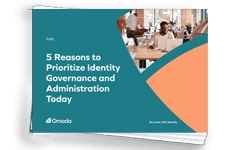Today, many organizations are evaluating artificial intelligence (AI) for identity governance to monitor user behavior more effectively and help create improved security systems. In The State of Identity Governance 2024 nearly 53 percent of 567 IT professionals and business leaders surveyed reported that functionality supporting AI in identity and access management was a top-five priority when evaluating a new Identity Governance and Administration (IGA) solution for deployment. We expect this number to rise as more IT administrators conclude that using legacy systems to apply access controls and manually review user access behavior across new platforms like SaaS applications is an unsustainable process. Even with many modern IGA solutions, certification fatigue is a common occurrence. AI-driven solutions based on machine learning (ML) dramatically improve the user identity review process and drive improved security overall.
In this post, we’ll explain AI for identity governance, go over specific use cases, and address the benefits AI-powered security offers as well as the risks and limitations of an AI-driven security strategy. Next, we’ll suggest how to use AI access control to automate user access reviews and leverage AI-driven analytics to make the most out of AI for identity governance. Finally, we’ll make some recommendations on how to get started with using machine learning in identity and access management. But first, let’s explain the difference between AI and ML.
Difference between AI and ML
- Artificial Intelligence is a broad field, which refers to the use of technologies to build machines that can mimic cognitive functions associated with human intelligence and appear human.
Examples: Large language models used by Chatbots, word complete on phones, self-driving cars, etc.
Benefits: It has the impressive ability to ‘appear human’ in certain contexts.
Risks: There is a temptation to go “all in” too quickly or without human supervision.
- Machine Learning is a subset of AI that enables a system to learn and improve from experience using algorithms to analyze large amounts of data, learn from the insights, and then make informed decisions.
Examples: Pattern recognition, anomaly detection, propensity models, categorization, etc.
Benefits: Highly explainable models, scalable over large datasets.
Risks: Lacks excitement, very narrow focus, requires a lot of clean data (garbage in, garbage out).
How AI for identity governance can help establish deeper trust in Identity security
AI for identity governance can enable organizations to use artificial intelligence technology to ensure that the right individual users have the right access to the applications and systems they require to do their job, throughout the identity lifecycle from on-boarding on day one to off-boarding. AI for identity governance helps organizations enhance security, streamline access management, and adapt to evolving security threats by leveraging advanced analytics and automation capabilities.
Here is some of the functionality AI enhances:
- User identity verification. AI-driven identity governance uses biometric data (e.g., facial recognition, voice recognition, fingerprint recognition, etc.) to verify user identity and ensure that the people accessing sensitive systems and applications in an organization are who they purport to be. AI-powered user verification goes beyond other types of multi-factor authentication (MFA) to provide another level of identity security.
- User access management. AI solutions facilitate Role-Based Access Control (RBAC) by analyzing an individual’s role within an organization and assigning the proper access permissions based on predefined roles. The user access review automation that AI algorithms provide help optimize access management and reduce the risk of unauthorized access.
- User behavior analysis. AI algorithms optimize anomaly detection. If a user unexpectedly accesses data beyond what is necessary to fulfill their job responsibilities, the system identifies the activity as a possible security risk.
- Security risk assessment. Artificial intelligence based on machine learning analyzes critical risk factors to assess the appropriateness of user activities or access requests. This includes analyzing contextual information and user behavior to ascertain the likelihood of a security risk.
- Access policy contextualization. AI algorithms account for information such as location, time of day, device used, etc. to make better decisions regarding access rights. For example, if a user is trying to access sensitive data from an unfamiliar location, the system may prompt for additional verification.
- User identity lifecycle management. AI automates provisioning and deprovisioning, the process of assigning access rights at onboarding and revoking access at offboarding.
- Security policy enforcement. AI for identity governance facilitates consistent enforcement of organizational identity and access management policies, ensuring organizations follow security policies to meet regulatory requirements.
- Continuous data access monitoring. AI enables real-time threat detection and can trigger alerts or automated responses when suspicious activity is identified to head off potential security breaches.
- Access controls adaptation. AI algorithms can customize authentication requirements to perceived risk levels. For instance, if a user is accessing sensitive data from an unusual location, the system may demand additional user authentication.
Getting the most out of AI for identity governance
Adopting AI for identity governance is the first step to reducing the identity-related threat surface with which your organization contends. Once you have automated processes in place, you also need a defined process for turning what your AI-powered solution provides into actionable intelligence.
Here are 3 ways of leveraging AI-driven data and ML-powered analytics to help your Identity Governance program:
- Automated recommendations and chat-assisted AI reduce the learning curve associated with access requests and approvals, driving efficiencies in the onboarding process and empowering IT administrators and users to be more productive from day one.
- Role discovery to be able to identify which identities share levels of access to lead to easier assignments of future identities, saving time and ensuring the right level of access for the right identity.
- Enhanced reporting that could analyze identity assignments over time, topology, or resources.
As we can see, there is tremendous upside in adopting AI as part of identity governance. However, there are risks that you need to consider. It is important to ensure your automated processes do not create a false sense of security. Your administrators must pay close attention to the automated process to ensure the algorithms are working as intended. For example, AI-powered role mining helps organizations gain contextualized user access control to address potential security risks. Another issue is data privacy. AI-driven identity and access management analyzes personally identifiable information that must be protected against cyberattacks. You must also consider that data protection regulations are evolving and what may not be considered sensitive data today may be tomorrow.
Getting started with AI for identity governance
Adopt a system that provides a comprehensive and automated approach to identity and access management and enables your organization to meet its security, compliance, and efficiency needs. In this system, AI-powered functionality takes core identity and access management capabilities to the next level by automating identity verification, role-based access control, and identity lifecycle management. AI algorithms then turn the insights they uncover into actionable information you can analyze to optimize your identity security strategy. To make it all work seamlessly, you must apply a defined best practice standard process to ensure the adopted system truly satisfies your business and security requirements.
Watch our webinar on AI Do’s and Don’ts to learn more about AI and ML and how it could apply to your identity governance program.
AI’s Do’s and Don’ts for Identity Governance on-demand webinar




























